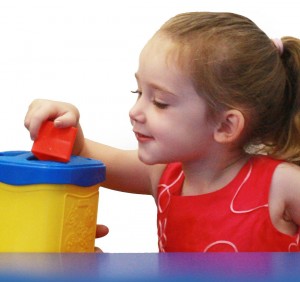
Christmas is coming and soon most children will be lucky enough to receive new toys to play with. A few weeks ago we looked to the "Hanen program" for some ideas about getting the most out of sharing books with your child. Today we will look to Hanen again for some ways to get the most out of all those new Christmas toys that will arrive very soon. The most important part of playing with your child is having fun together. When you are having fun together, you are helping your child develop their communication skills
Play is one of the most important ways that your child learns about the world. From playing with adults and children, your child learns how to interact and get along with others. Play also helps develop your child’s problem-solving skills. By experimenting with toys, your child will make interesting discoveries (e.g. which toys float in the bath). Playing with materials like paper, glue, playdough, paint and sand helps develop creativity and imagination.
The best thing about play is that it helps your child learn many, many words and important ideas about the world. Your child will learn that they go up the stairs and down the slide. Your child will discover that block is too big to fit into a little cup, and your child may pretend that the soup they have just made for you is too hot. Once your child understands these words and ideas, they may be ready to try saying them. It is easy to see that play skills and communication skills develop hand in hand.
Get Involved in the Play
A successful play activity begins with you and your child interacting and having fun. To get things going, keep in mind these three strategies:
1. Join in the play
Find a way to join in with what your child is doing. If your child doesn’t play with the toys the way you expect them to, just ‘go with the flow’. Let them explore and enjoy the toys in their own way and see where they play takes you. The communication between you doesn’t have to be about anything in particular. What is important is simply that you and your child are communicating.
2. Create opportunities for your child to take turns
If your child doesn’t include you in their play even when you join in, you will have to find another way in. One way to get involved in the play is by creating opportunities for your child to take turns in the interaction. You can do this by making sure that your child needs to communicate with you to get what you want. For example, choose a toy that they can’t operate on their own, or hold on to pieces they need to operate the toy.
3. Use play routines to SPARK an interaction
Start the same way each time
Plan your child’s turn
Adjust the routine so your child can take their turn
Repeat the same actions, sounds and words each time
Keep the end the same
Go With Games
Games can help your child to:
- Learn actions and sounds
- Practice taking turns
- Practice taking chances
- Discover pretending
- Learn to get along with others
Playing Games
Allow your child to lead by thinking like a child.
Remember to:
- Play face to face
- Imitate your child to help them copy you
- Interpret: say what your child would say if she could talk
- Watch for your child taking a turn and help them extend this
Add new experiences and words by:
- Using gestures
- Making important words stand out
- Adding a word or action
- Repeat, repeat, repeat
- Building on what your child knows
Ideas for Games
Babies & Toddlers
Pre-Schoolers
School Age
Patter cake, peek a boo and hiding Pots and pans
Nursery rhymes
Games with blocks
Games with balls
Simple card games and puzzles
Simple pretend play and dress ups
Cars, trucks and trains Dolls, puppets and fluffy animals
Blocks with farm animals
Card games
Simple board games
Dressing up and pretending
Tea sets, cooking and cleaning sets
More complex card and board gamesPretending with more complex props
For more ideas on play and communication just for your child's age check the "what to expect" part of Our website. There are also lots of great ideas on our Pinterest page. If you have some fun playing with your child's new toys why not share it on our Facebook page.
This information has been compiled using the Hanen books “It Takes Two to Talk” by Jan Pepper and Elaine Weitzman (2004), and “You Make the Difference In Helping Your Child Learn” by Ayala Manolson, Barbara Ward, and Nancy Dodington (2007).
Talking Matters wishes all our families, friends and colleagues a safe and happy Christmas.
Related Blog Posts
If you liked this post you may also like:
Talking diagnosis
Language Games
FAQ about therapy
Sleep - Supporting You Child's Development



